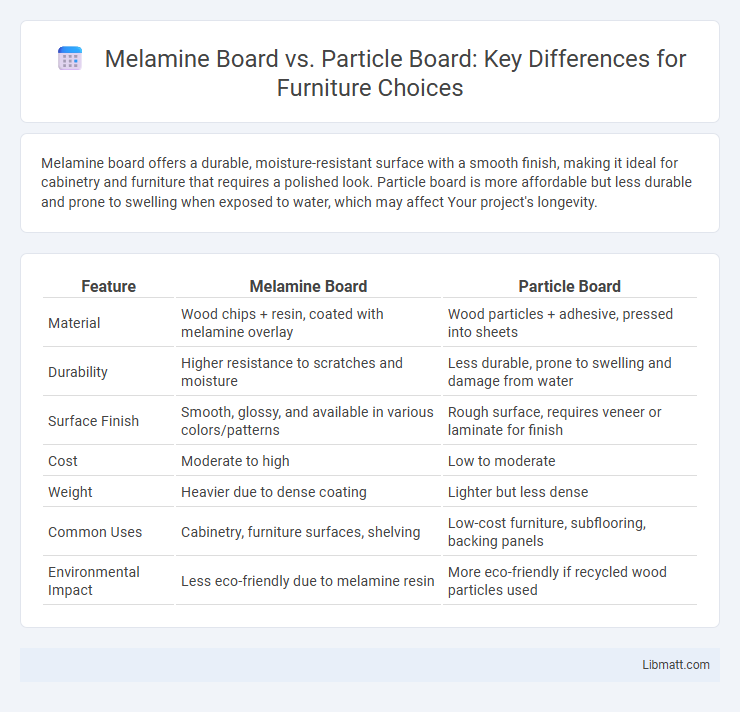Melamine board offers a durable, moisture-resistant surface with a smooth finish, making it ideal for cabinetry and furniture that requires a polished look. Particle board is more affordable but less durable and prone to swelling when exposed to water, which may affect Your project's longevity.
Table of Comparison
| Feature | Melamine Board | Particle Board |
|---|---|---|
| Material | Wood chips + resin, coated with melamine overlay | Wood particles + adhesive, pressed into sheets |
| Durability | Higher resistance to scratches and moisture | Less durable, prone to swelling and damage from water |
| Surface Finish | Smooth, glossy, and available in various colors/patterns | Rough surface, requires veneer or laminate for finish |
| Cost | Moderate to high | Low to moderate |
| Weight | Heavier due to dense coating | Lighter but less dense |
| Common Uses | Cabinetry, furniture surfaces, shelving | Low-cost furniture, subflooring, backing panels |
| Environmental Impact | Less eco-friendly due to melamine resin | More eco-friendly if recycled wood particles used |
Introduction to Melamine Board and Particle Board
Melamine board is a type of engineered wood product coated with a durable resin-infused paper, providing a smooth, decorative, and moisture-resistant surface ideal for furniture and cabinetry. Particle board consists of wood chips, sawmill shavings, and sawdust bonded together with synthetic resin, offering a cost-effective but less durable base material for interior applications. Both materials serve distinct purposes in woodworking, with melamine boards excelling in aesthetics and moisture resistance, while particle boards are favored for budget-friendly structural uses.
Composition and Material Differences
Melamine board consists of a particleboard or MDF core coated with a durable melamine resin layer, offering enhanced surface hardness and resistance to scratches and moisture. In contrast, particle board is made from compressed wood chips, sawdust, and resin without any decorative surface layer, making it less resistant to wear and moisture. Your choice depends on the need for surface durability and moisture resistance, where melamine board provides superior material performance compared to standard particle board.
Manufacturing Process Comparison
Melamine boards are manufactured by fusing a resin-saturated paper layer onto particle board under high heat and pressure, creating a durable, smooth, and decorative surface. Particle boards are produced by compressing wood chips, sawdust, and resin binders into dense panels without any surface lamination, resulting in a more porous and less moisture-resistant material. The melamine overlay enhances the particle board's strength and aesthetic appeal, making melamine boards more suitable for furniture and cabinetry compared to unfinished particle boards.
Surface Finish and Appearance
Melamine board features a smooth, durable surface finish that resists scratches, stains, and moisture, making it ideal for furniture and cabinetry with a clean, polished look. Particle board often has a rougher texture and requires a veneer or laminate layer to enhance its appearance and protect against damage. You can rely on melamine boards for a more consistent and visually appealing surface compared to the variable finish of coated particle boards.
Durability and Strength
Melamine boards offer superior durability and strength compared to particle boards due to their resin-infused surface, which resists scratches, moisture, and stains effectively. Particle boards tend to be less dense and weaker, making them more prone to swelling and damage when exposed to water or heavy loads. Choosing melamine board ensures longer-lasting furniture and cabinetry with enhanced structural integrity in high-use environments.
Moisture and Heat Resistance
Melamine board offers superior moisture and heat resistance compared to particle board, making it ideal for kitchen cabinets and bathroom furniture where exposure to humidity and temperature variations is common. Particle board tends to swell and deteriorate when exposed to moisture, compromising its structural integrity over time. Using melamine board ensures your furniture remains durable and maintains its appearance despite challenging environmental conditions.
Cost and Budget Considerations
Melamine board typically costs more than particle board due to its enhanced durability and decorative surface, making it a preferred choice for budget-conscious projects that require a polished finish. Particle board is more affordable, offering a low-cost option for furniture and cabinetry, but it often requires additional finishing or lamination to match the appearance and moisture resistance of melamine board. Budget considerations should weigh the initial material cost against long-term durability and maintenance expenses when choosing between melamine and particle board.
Applications and Use Cases
Melamine board is ideal for cabinetry, furniture, and wall panels due to its smooth finish, durability, and resistance to moisture and scratches, making it perfect for kitchens and offices. Particle board is commonly used in budget-friendly furniture, underlayment, and shelving where cost-effectiveness is prioritized over moisture resistance and aesthetics. Your choice between the two should consider the specific application requirements, such as exposure to moisture and desired surface quality.
Environmental Impact and Sustainability
Melamine board generally has a lower environmental impact than particle board due to its durability and resistance to moisture, which extends its lifespan and reduces waste. Particle board, often made from recycled wood chips and resin, offers a sustainable use of wood by-products but tends to emit higher formaldehyde levels, raising indoor air quality concerns. Choosing melamine board with low-formaldehyde adhesives or particle board certified for low emissions supports sustainability and healthier environments.
Pros and Cons: Melamine Board vs Particle Board
Melamine board offers a durable, water-resistant surface ideal for kitchen cabinets and furniture, while particle board is more affordable but prone to moisture damage and warping. Melamine's smooth finish resists scratches and stains better than particle board, which often requires laminates or veneers for protection. Your choice depends on budget constraints and the need for durability in high-use areas.
Melamine board vs particle board Infographic

 libmatt.com
libmatt.com